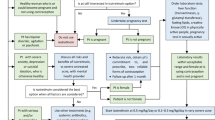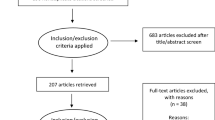Abstract
Objective
Sweet’s syndrome (SS) is characterized by various clinical symptoms, physical features, and pathological findings. Although cases of SS are very rare, there has been an increase in the incidence of drug-induced SS. Till date, there have been only few reported cases of isotretinoin-induced SS.
Case summary
In this report, we describe the case of a 19-year-old girl who developed SS after systemic treatment with oral isotretinoin for nodulocystic acne.
Conclusions
The findings of this report emphasize the importance of evaluating isotretinoin as a possible, though uncommon, cause of SS and replacing it with another treatment if its involvement is suspected.
Similar content being viewed by others
Background
Sweet’s syndrome (SS) is characterized by painful erythematous skin lesions due to neutrophil infiltration in the upper dermis, fever, leukocytosis with a predominance of neutrophils, and increased erythrocyte sedimentation rate (ESR) [1],[2]. There are three clinical forms of SS: classical (idiopathic), malignancy associated, and drug induced [3]. Classical SS usually develops in women aged between 30 and 40 years and is often preceded by upper respiratory or gastrointestinal tract infection, inflammatory bowel disease, and pregnancy. Malignancy-associated SS can occur as a paraneoplastic syndrome. Drug-induced SS most commonly occurs in patients who have been treated with granulocyte colony-stimulating factor [3]. Although this form of SS is very rare, there has been an increase in the incidence of drug-induced SS [4]. Here we describe the case of a 19-year-old girl who developed drug-induced SS after systemic treatment with oral isotretinoin (13-cis-retinoic acid) for nodulocystic acne and emphasize the importance of evaluating isotretinoin as a possible, though uncommon, cause of SS.
Case presentation
A 19-year-old girl presented to the rheumatology clinic because of malaise, polyarthralgia, and weight loss (5 kg), which she experienced during six months before presentation to the clinic. She did not have any fever during presentation to the clinic. During two weeks before presentation to the clinic, she developed very painful and tender skin lesions on her legs and in the suprapubic area. Her medical history was insignificant. She had no history of inflammatory bowel disease or rheumatological disease. She did not have symptoms indicative of contact dermatitis or any history of drug intake, except for the use of isotretinoin for severe facial acne vulgaris, which was initiated one year ago at a dose of 20 mg twice daily and was tapered gradually to a dose of 20 mg weekly. A similar lesion appeared 1 month after the initiation of isotretinoin therapy. These lesions resolved without intervention. However, the lesions at the time of presentation to the clinic were more severe and painful, and the patient was admitted to the hospital for clinical evaluation. Physical examination showed that she was unnaturally thin and that she looked ill. Her vital signs were not remarkable, and she did not have fever, lymphadenopathy, hepatosplenomegaly, and other symptoms. Dermatological examination showed tender erythematous plaques with pustules and crust on the ventromedial aspects of her mid-thighs, suprapubic region, and right calf [Figure 1]. Initial laboratory examination determined leukocytosis (23100 cells/mm3) and neutrophilia (65%). Group A streptococcal throat culture and anti-streptolysin O titers were negative. Her ESR was >100. Antineutrophil cytoplasmic antibody and antinuclear antibody titers and blood, wound, and urine cultures were negative. Tuberculosis skin test (PPD skin test) provided insignificant results. Kidney and liver function tests, urine analysis, echocardiography, chest radiography, and total abdominopelvic sonography yielded normal results. Bone marrow aspiration and biopsy yielded normal results. Therefore, hematological and solid organ malignancies were ruled out. Skin punch biopsy from a new, well-developed lesion showed spongiotic epidermis with mild dermal edema. Massive aggregates of neutrophils were observed in the upper and mid-dermis, but there was no obvious sign of vasculitis [Figure 2]. Thus, the patient was diagnosed as having drug-induced SS due to isotretinoin based on the above observations and criteria for SS. Isotretinoin therapy was stopped, and prednisolone therapy was initiated at a dose of 60 mg/day (1 mg/kg). Dose tapering was initiated after 2 weeks; after 6 weeks, the dose was tapered to 5 mg/day. Complete resolution of the lesions was observed within 4 weeks. The patient was advised to avoid isotretinoin and asked to return for follow-ups.
Ethical approval
This is a report of rare case, however the report was approved by the Ethics Committee of Semnan University of Medical Sciences, Semnan, Iran.
Conclusions
Etiologically, SS may be associated with drugs, infections, and paraneoplastic or inflammatory conditions such as inflammatory bowel diseases and rheumatological diseases. When no triggering factor is detected, the disease is categorized as classic or idiopathic [4].
Only few cases of SS have been reported to be caused by drug reactions. Drug-induced SS is rare and probably represents <5% of all cases [5]. The clinical presentation and histology of drug-induced SS are similar to those of idiopathic SS [6]. Neutrophilia is often absent in drug-induced SS probably because many of these cases are caused by the use of hematopoietic growth factors that are used for reversing chemotherapy-induced neutropenia. Lesions in drug-induced SS usually develop approximately one week after the initiation of the drug [7]. After withdrawing the causative drug, fever abates in 1-3 days and lesions disappear within 3-30 days [5]. Systemic corticosteroids may be required in severe cases. Drugs associated with drug-induced SS include all-trans-retinoic acid and G-CSF or GM-CSF [5]. Some cases may be attributed to trimethoprim/sulfamethoxazole, norfloxacin, furosemide, celecoxib, tetracyclines, and antiepileptic drugs [4],[7]. Other implicated drugs are summarized in Table 1[4].
Drug-induced SS is uncommon. Because of the lack of useful and appropriate criteria for its diagnosis, Walker and Cohen proposed five specific diagnostic criteria in 1996 [7]. Thompson and Montarella performed a systematic review of literature on drug-induced SS and evaluated the degree of causal relationships in different case reports [4]. In our case, we used the modified Naranjo criteria to diagnose drug-induced SS [4]. The modified scale includes 10 criteria: presence of previous conclusive reports; temporary onset related to drug administration; temporary resolution of lesions after drug withdrawal or treatment with a specific antagonist; temporary recurrence of lesions due to drug readministration; presence of alternative causes (other than drugs) that could cause the reaction; appearance of lesions after placebo administration; drug detection in the blood (or other fluids) at concentrations known to be toxic; role of drug dosage in the worsening or improvement of the reaction; history of exposure to the same or similar drugs, followed by a similar reaction; and confirmation of an adverse event by any objective evidence [4]. The case reported here had a causality score of 4 based on the above criteria (Possible). This score was not higher because no rechallenge was performed due to the severity of the symptoms. There were no signs of any inflammatory disease, neoplasia, or pregnancy. To the best of our knowledge, this is the third case of SS caused by isotretinoin and the second case of SS caused by isotretinoin therapy for acne vulgaris.
The first case was reported by Gyorfy et al in 2003. They reported the cases of two children who developed SS due to isotretinoin administration. However, the children were administered this drug to prevent neuroblastoma recurrence and dysplastic colon re-emergence after bone marrow transplantation and not for acne treatment [8].
The other case of isotretinoin-induced SS was reported by Ammar et al. in 2007 in a 19-year-old man who received isotretinoin for severe acne vulgaris that was resistant to standard topical acne treatment. After one week of the treatment, the patient developed SS. His condition was improved by continuing isotretinoin and by initiating corticosteroids. However, he was diagnosed as having ulcerative colitis two years later [9].
In drug-induced SS, a pre-existing underlying condition associated with SS should be excluded. Clinical criteria can help in distinguishing drug-induced SS from underlying conditions. Based on the observation made in this case, we emphasize the importance of evaluating isotretinoin as a possible, though uncommon, cause of SS and replacing it with other treatments if its involvement is suspected.
Consent
Written informed consent was obtained from the patient for the publication of this report.
Authors’ contributions
JM and MP was managing the case.MP, DP and MA drafting the paper. JM and HH were managing the case and scientific editing of the manuscript. All authors read and approved the final manuscript.
Abbreviations
- SS:
-
Sweet’s syndrome
- ESR:
-
Erythrocyte sedimentation rate
References
Cohen PR, Kurzrock R: Sweet’s syndrome revisited: a review of disease concepts. Int J Dermatol. 2003, 42: 761-778. 10.1046/j.1365-4362.2003.01891.x.
Neoh CY, Tan AWH, Ng SK: Sweet’s syndrome: a spectrum of unusual clinical presentations and associations. Br J Dermatol. 2007, 6 (3): 480-485. 10.1111/j.1365-2133.2006.07677.x.
Bonamigo RR, Razera F, Olm GS: Neutrophilic dermatoses: part I. An Bras Dermatol. 2011, 86 (1): 11-25. 10.1590/S0365-05962011000100002.
Thompson DF, Montarella KE: Drug-induced Sweet’s syndrome. Ann Pharmacother. 2007, 41: 802-811. 10.1345/aph.1H563.
Roujeau JC: Neutrophilic drug eruptions. Clin Dermatol. 2000, 18: 331-337. 10.1016/S0738-081X(99)00124-8.
Saez M, Garcia-Bustinduy M, Noda A, Dorta S, Escoda M, Fagundo E: Drug-induced Sweet’s syndrome. J Eur Acad Derm Venereol. 2004, 18: 233-10.1111/j.1468-3083.2004.00866.x.
Walker DC, Cohen PR: Trimethoprim-sulfamethoxazole-associated acute febrile neutrophilic dermatosis: case report and review of drug-induced Sweet’s syndrome. J Am Acad Dermatol. 1996, 34: 918-923. 10.1016/S0190-9622(96)90080-8.
Gyorfy A, Kovács T, Szegedi I, Oláh E, Kiss C: Sweet syndrome associated with 13-cis-retinoic acid (isotretinoin) therapy. Med Pediatr Oncol. 2003, 40 (2): 135-136. 10.1002/mpo.10089.
Ammar D, Denguezli M, Ghariani N, Sriha B, Belajouza C, Nouira R: Sweet’s syndrome complicating isotretinoin therapy in acne. Ann Dermatol Venereol. 2007, 134 (2): 151-154. 10.1016/S0151-9638(07)91608-7.
Author information
Authors and Affiliations
Corresponding author
Additional information
Competing interests
The authors declare that they have no competing interests.
Authors’ original submitted files for images
Below are the links to the authors’ original submitted files for images.
Rights and permissions
Open Access This article is licensed under a Creative Commons Attribution 4.0 International License, which permits use, sharing, adaptation, distribution and reproduction in any medium or format, as long as you give appropriate credit to the original author(s) and the source, provide a link to the Creative Commons licence, and indicate if changes were made.
The images or other third party material in this article are included in the article’s Creative Commons licence, unless indicated otherwise in a credit line to the material. If material is not included in the article’s Creative Commons licence and your intended use is not permitted by statutory regulation or exceeds the permitted use, you will need to obtain permission directly from the copyright holder.
To view a copy of this licence, visit https://creativecommons.org/licenses/by/4.0/.
About this article
Cite this article
Moghimi, J., Pahlevan, D., Azizzadeh, M. et al. Isotretinoin-associated Sweet’s syndrome: a case report. DARU J Pharm Sci 22, 69 (2014). https://doi.org/10.1186/s40199-014-0069-2
Received:
Accepted:
Published:
DOI: https://doi.org/10.1186/s40199-014-0069-2






